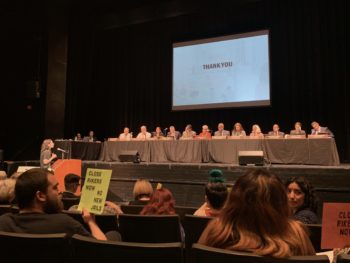
Meetings like this City Planning Commission public hearing that were moved to safely accommodate a larger crowd are an example of how public bodies can adapt to safely hold in-person hearings post pandemic. Image Credit: CityLand
On June 23, 2021 Governor Andrew Cuomo announced that the state’s COVID-19 emergency orders, which are set to expire today will not be renewed. One of the provisions within the emergency order adjusted the requirements of the Open Meetings Law to allow public hearings to be held remotely via telephone or video conference or other similar service. As of Friday, June 25th, the Open Meetings Law will again require all meetings to be held in-person.
Will In-Person Meetings Have Health Safety Protocols in Place?
As more and more people become vaccinated, COVID protocols have become more lax. This has included lifting mask requirements for businesses and sporting events as well as lifting social distancing requirements. However, some institutions are still requiring protocols. Will government public meetings require safety protocols?
Section 103(d) of the Open Meetings Law requires public bodies to “make or cause to be made all reasonable efforts to ensure that meetings are held in an appropriate facility which can adequately accommodate members of the public who wish to attend such meetings.” In the context of a continuing pandemic, where City workplaces are still requiring face masks and social distancing, does an “appropriate facility” for a meeting look different?
Prior to the pandemic, public meetings ranged from no one in attendance to hundreds of people lining up to testify about critical issues. In a post-COVID world, will the City need to rethink the spaces used to host these meetings to allow them to happen safely? Is there even enough space in some of these agency offices to allow for socially distanced meetings that could accommodate the public? It wouldn’t be the first time an agency has changed venue to hold a public meeting; in July 2019 the City Planning Commission held its public hearing on the controversial borough based jails project at the John Jay College of Criminal Justice instead of its offices in the Equitable Building.
Were interactive remote hearings more transparent and accessible than in-person hearings before Covid-19?
The end of remote hearings also raises questions about accessibility and community engagement. Remote hearings allowed for people to testify live over the phone from their homes or offices and provided easier access for people with disabilities and families.
Prior to the pandemic, the City Council and some city agencies like the City Planning Commission and the Landmarks Preservation Commission already streamed their in-person public hearings online. Viewers could watch remotely, but to actively participate and provide live testimony members of the public would have to attend in person. This would require people to not have work, school or family obligations before and during meeting times and the physical and financial ability to travel down to the office where the hearing was being held.
There are also lessons to be learned from how various agencies were able to adapt to remote hearings versus how community boards adapted. While many agencies were already accustomed to live streams before COVID, many community boards did not have those capabilities. Community boards like Brooklyn CB10 sought out discretionary funding from their Council Members to be able to stream. The introduction of Web-Ex and Zoom during the pandemic, became a natural way for Community Boards to live stream, and increase public participation that they may now lose switching back to in-person meetings. There should be further consideration of how we can make community boards more accessible now that remote hearings are no longer needed.
It will be interesting to see the return of in-person meetings and how participation changes. While testimony has and will continue to be accepted over various forms of communication, there is something to be said about the power of people being able to directly address the elected or appointed officials in charge of the decisions that impact their lives. To encourage public engagement and participation within our democracy, we should take the lessons learned about how the government can adapt and re-exam what can be done to make public hearings more accessible, and transparent.
We encourage the Mayor, city agencies, and the City Council to ask these questions, and come up with solutions that can take the best parts of in-person meeting and meld them with the positives that came from the virtual world in the COVID era.
Regardless of what happens, we at CityLand promise to continue to provide coverage of the land use public review process in the City to promote transparency, public awareness, and civic engagement.
By: Veronica Rose (Veronica is the CityLaw fellow and a New York Law School graduate, Class of 2018) and Brian Kaszuba (Brian is the managing editor of CityLand and a New York Law School graduate, Class of 2004.)


This discussion is a great opener to an important issue.